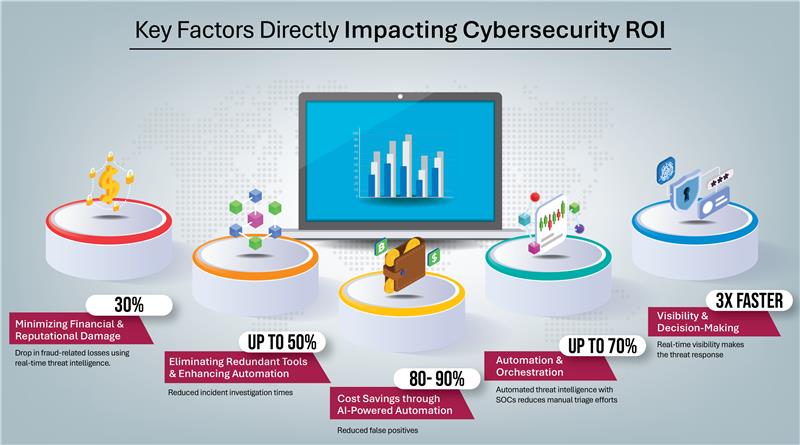Why Cyber Threat Intelligence Is the Key to Maximizing ROI
Investing in cybersecurity is a balancing act because organizations want robust protection without overspending. While threat intelligence is often viewed narrowly as a tool for threat detection, its true value extends much further, playing an important role in enhancing prevention, response, and decision-making.
Some studies reveal the substantial ROI that comprehensive threat intelligence can deliver. For instance, organizations utilizing advanced threat intelligence solutions have reported significant benefits, including cost savings from avoided breaches and improved operational efficiency.
In this blog, we will explore how moving beyond basic threat detection can transform your cybersecurity strategy, helping you protect your organization while optimizing your investment.
The True Scope of Threat Intelligence
To truly maximize ROI with threat intelligence, organizations must move beyond surface-level threat detection and leverage intelligence for prevention, rapid response, and strategic decision-making.
Before a breach happens, businesses should proactively upgrade their defenses by regularly reviewing attack trends and vulnerabilities. These are cyber threat intelligence’s most important advantages.
- Prevention & Risk Mitigation
Using threat intelligence, organizations can proactively patch security gaps, block malicious activity, and prevent costly breaches. This approach improves cybersecurity ROI by reducing incident-related expenses.
- Incident Response Acceleration
Speed is critical when responding to cyber threats. Faster response times mean reduced containment costs, minimized downtime, and lower financial losses, directly contributing to ROI with threat intelligence.
- Strategic Security Posture
Beyond individual incidents, cyber threat intelligence plays a crucial role in shaping an organization’s overall cybersecurity strategy. This ensures a well-prioritized, cost-effective defense strategy, optimizing resources while maximizing cybersecurity ROI.
This forethought reduces the operational and financial harm that cyber events might inflict.
Key Factors Directly Impacting Cybersecurity ROI
Investing in threat intelligence isn’t just about security, it’s about making cybersecurity more cost-effective, efficient, and strategic. To maximize ROI with threat intelligence, organizations must focus on key factors that directly impact financial and operational returns.
1. Financial & Reputational Damage
Cyber breaches are costly, not just in terms of financial losses but also reputational harm. In 2025, the average data breach cost has surpassed $4.7 million, according to IBM’s Cost of a Data Breach Report.
- Threat intelligence helps businesses identify and neutralize threats before they escalate, preventing regulatory fines, legal fees, and brand damage.
- For example, financial institutions using real-time threat intelligence have reported a 30% drop in fraud-related losses by detecting and blocking fraudulent transactions before they happen.
The team’s expertise and experience can help them lower business risk and avoid hefty remediation costs.
2. Redundant Tools & Enhancing Automation
One of the biggest challenges enterprise security teams face today is tool sprawl, deploying multiple security solutions that overlap in functionality but fail to work cohesively.
This not only inflates costs but also overwhelms security teams with redundant alerts, making it harder to detect and respond to real threats effectively.
- For instance, companies that replaced fragmented security tools with a centralized threat intelligence platform have reduced incident investigation times by up to 50%, freeing cybersecurity teams for more strategic tasks.
- By consolidating security spending into centralized solutions that integrate multiple tools, organizations can significantly cut costs while improving threat detection and response efficiency.
- Instead of managing a patchwork of disconnected solutions, a unified platform centralizes intelligence, reducing unnecessary software licenses, maintenance fees, and integration complexities.
Organizations that manage their security operations through centralized achieved four times greater ROI than those relying on scattered tools, despite spending less overall.
The reason?
- Integrated threat intelligence platforms reduce false positives
- Automate threat correlation
- Enhance response time, eliminating the need for excessive manual intervention.
This approach directly enhances efficiency and contributes to ROI with threat intelligence.
3. Cost Savings through AI-Powered Automation
AI-driven threat intelligence is a game-changer for cost optimization. AI can analyze vast amounts of threat data instantly, flagging risks before they cause damage. Businesses adopting AI-powered threat intelligence have reduced false positives by 80- 90%, significantly cutting down analyst workload and operational costs.
Instead of hiring large security teams to manually analyze alerts, AI automates threat detection and response, leading to millions in savings while strengthening defenses, and boosting cybersecurity ROI.
4. Non-Tangible Gains: Visibility & Decision-Making
Not all benefits of threat intelligence are immediately quantifiable, but they hold immense value. Enhanced visibility into threat landscapes enables better decision-making, faster incident response, and a more resilient security posture.
For example, companies using predictive threat intelligence can anticipate attack patterns, allowing CISOs to justify security budgets based on real-world risks rather than guesswork.
This advantage ensures that investments are made in the most critical areas, optimizing ROI with threat intelligence.
5. Automation & Orchestration: Eliminating Unnecessary Costs
Security teams often suffer from alert fatigue, with thousands of alerts bombarding them daily.
- By integrating automated threat intelligence with SOCs, organizations have reduced manual triage efforts by up to 70%, cutting labor costs while improving response efficiency.
- This orchestration prevents redundant spending on overlapping tools, directly contributing to cybersecurity ROI.
By focusing on these key factors, organizations can leverage threat intelligence as a force multiplier, ensuring stronger security while maximizing financial returns.
Factors that Matter for ROI
Compliance is a major factor that aligns with regulatory frameworks like HITRUST, GDPR, and CMMC 2.0 to reduce legal and financial risks.
- Comparing costs before and after intelligence adoption (e.g., reduction in breach-related expenses).
- Tracking analyst workload reduction (e.g., improved efficiency due to AI-driven triage).
- Assessing the financial impact of security automation (e.g., savings from fewer manual investigations).
- How many threats were neutralized before impact?
- How much faster were security teams able to react?
- What financial impact did threat intelligence have?
Author
-

Richa Arya is the Senior Executive Content Marketer and Writer at Network Intelligence with over 5 years of experience in content writing best practices, content marketing, and SEO strategies. She crafts compelling results-driven narratives that align with business goals and engage audiences while driving traffic and boosting brand visibility. Her expertise lies in blending creativity with data-driven insights to develop content that resonates and converts.
View all posts
